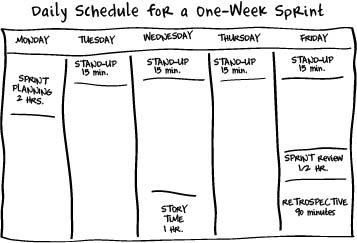‘The Elements of Scrum’
by Chris Sims and Hillary Louise Johnson
Roles
Product Owner
- Holds the vision for the product
- Represents the business
- Represents the customers
- Owns the product backlog
- Prioritizes stories
- Creates acceptance criteria for stories
- Is available to answer the team’s questions
Scrum Master
- Knows/advises about scrum
- Coaches teammates
- Facilitates and removes impediments to the team
Team Member
- Delivers user stories
- Does all the development work
- Self-organizes
- Owns the estimation process
- Makes technical decisions (“how to do the work”)
- Avoids saying “not my job”
The Sprint

Sprint Planning (~2 hr)
- What will we do?
- How will we do it?
Stand-up (daily, 15 min)
- What I did yesterday
- What I’ll do today
- Blockers
Backlog Grooming (~1 hr)
Sprint Demo (30 min - 1 hr)
Retro
- What went well
- What didn’t go well
- Things to do (“action items”)
Scrum Artifacts
- Product Backlog
- Sprint Backlog
- “Information Radiators”: burn charts, task board…
- Definition of Done
Estimation
Part I: The Big Line-Up
Each player takes a turn, in which they may do any one of the following actions:
- Place a new story card on the wall.
- Mover a previously placed story card. It is perfectly OK to slide cards down to make room for the repositioned card, so long as the ordering of the other cards is preserved.
- Pass the turn to the next player.
Cards are placed left to right, smallest to largest. It pays to space them widely so you can easily change the order later. Play continues until every player has passed.
Part II: What’s Your Number?
Each player takes a turn, in which they may do any one of the following actions:
- Place the next Fibonacci card above a story card, indicating where the next increase in story size occurs.
- Move a Fibonacci card to a different story. (The move must preserve the order of the number cards, i.e. one must come before two, 13 before 21…)
- Move a story card, just as in part one.
- Pass the turn to the next player.
Play continues until every player has passed, indicating that there are no more adjustments needed to the order of the stories, or the size assignments.